(R)-(-)-Phenylephrine
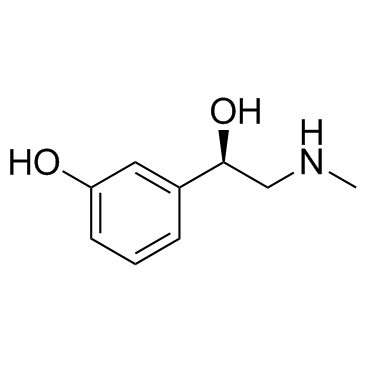
(R)-(-)-Phenylephrine structure
|
Common Name | (R)-(-)-Phenylephrine | ||
|---|---|---|---|---|
| CAS Number | 59-42-7 | Molecular Weight | 167.20500 | |
| Density | 1.159 g/cm3 | Boiling Point | 341.1ºC at 760 mmHg | |
| Molecular Formula | C9H13NO2 | Melting Point | 171°C | |
| MSDS | N/A | Flash Point | 163.4ºC | |
Use of (R)-(-)-Phenylephrine(R)-(-)-Phenylephrine is a selective α1-adrenoceptor agonist primarily used as a decongestant. |
| Name | phenylephrine |
|---|---|
| Synonym | More Synonyms |
| Description | (R)-(-)-Phenylephrine is a selective α1-adrenoceptor agonist primarily used as a decongestant. |
|---|---|
| Related Catalog | |
| In Vitro | (R)-(-)-Phenylephrine is a selective α1-adrenoceptor agonist with pKi values of 5.86, 4.87 and 4.70 for α1D, α1B and α1A receptors respectively[1][2]. Phenylephrine promotes cardiac fibroblast proliferation. Phenylephrine activates CaN and evokes NFAT3 nuclear translocation. It suggests that the Ca(2+)/CaN/NFAT pathway mediates phenylephrine -induced cardiac fibroblast proliferation, and this pathway might be a possible therapeutic target in cardiac fibrosis[3]. |
| In Vivo | Perfusion of hearts with 100 μM phenylephrine causes a rapid (maximal at 10 min) 12-fold activation of two p38-MAPK isoforms. α1-adrenoceptor agonists such as phenylephrine increase the contractility of the heart. Phenylephrine also activates SAPKs/JNKs in neonatal ventricular myocytes[4]. Phenylephrine could increase the alveolar fluid clearance in high tidal volume-ventilated rats and accelerate the absorption of pulmonary edema[5]. |
| Animal Admin | Rats: A total of 170 male Wistar rats are randomLy allocated into 17 groups (n=10) using random number tables. Short-term (40 minutes) mechanical ventilation with high tidal volume is performed to induce lung injury, impair active Na+ transport and lung liquid clearance in the rats. Unventilated rats serves as controls. To demonstrate the effect of phenylephrine on alveolar fluid clearance, phenylephrine at different concentrations (10, 1, 0.1, 0.01, and 0.001 μM) is injected into the alveolar space of the HVT ventilated rats[5]. |
| References |
| Density | 1.159 g/cm3 |
|---|---|
| Boiling Point | 341.1ºC at 760 mmHg |
| Melting Point | 171°C |
| Molecular Formula | C9H13NO2 |
| Molecular Weight | 167.20500 |
| Flash Point | 163.4ºC |
| Exact Mass | 167.09500 |
| PSA | 52.49000 |
| LogP | 1.03590 |
| Index of Refraction | -55.5 ° (C=5, 1mol/L HCl) |
CHEMICAL IDENTIFICATION
HEALTH HAZARD DATAACUTE TOXICITY DATA
|
| Hazard Codes | Xn |
|---|---|
| Risk Phrases | R22 |
| Safety Phrases | S26-S36-S45 |
| RTECS | DO7175000 |
|
~% 
(R)-(-)-Phenyle... CAS#:59-42-7 |
| Literature: WO2008/77560 A1, ; Page/Page column 10-11 ; |
|
~89% 
(R)-(-)-Phenyle... CAS#:59-42-7 |
| Literature: Divi's Laboratories Limited Patent: US2012/108848 A1, 2012 ; Location in patent: Page/Page column 4 ; |
|
~10% 
(R)-(-)-Phenyle... CAS#:59-42-7 |
| Literature: Lin, Wei-De; Chen, Chien-Yu; Chen, Huei-Chung; Hsu, Wen-Hwei Process Biochemistry, 2010 , vol. 45, # 9 p. 1529 - 1536 |
|
~% 
(R)-(-)-Phenyle... CAS#:59-42-7 |
| Literature: Tetrahedron Asymmetry, , vol. 21, # 20 p. 2479 - 2486 |
|
~% 
(R)-(-)-Phenyle... CAS#:59-42-7 |
| Literature: Applied Catalysis A: General, , vol. 439-440, p. 74 - 79 |
|
~% 
(R)-(-)-Phenyle... CAS#:59-42-7 |
| Literature: Applied Catalysis A: General, , vol. 439-440, p. 74 - 79 |
|
~% 
(R)-(-)-Phenyle... CAS#:59-42-7 |
| Literature: Monatshefte fuer Chemie, , vol. 80, p. 517,521,524,534 |
|
Histamine H4 receptor as a new therapeutic target for choroidal neovascularization in age-related macular degeneration.
Br. J. Pharmacol. 171(15) , 3754-63, (2014) The present treatment for choroidal neovascularization (CNV) associated with age-related macular degeneration (AMD) is not sufficient. Hence, we examined the therapeutic efficacy of reducing histamine... |
|
|
Transscleral delivery of Nd: YLF laser at 1,047 nm causes vascular occlusion in experimental pigmented choroidal melanoma.
Retina (Philadelphia, Pa.) 34(4) , 792-800, (2014) The aims of this study were to determine the scleral attenuation of focused neodymium: yttrium-lanthanum-fluoride laser at 1,047 nm applied transsclerally and whether transscleral delivery can close t... |
|
|
Protective Effects of Human iPS-Derived Retinal Pigmented Epithelial Cells in Comparison with Human Mesenchymal Stromal Cells and Human Neural Stem Cells on the Degenerating Retina in rd1 mice.
Stem Cells 33(5) , 1543-53, (2015) Retinitis pigmentosa (RP) is a group of visual impairments characterized by progressive rod photoreceptor cell loss due to a genetic background. Pigment epithelium-derived factor (PEDF) predominantly ... |
| Neophryn |
| Mydfrin |
| Mesatone |
| Mesaton |
| Phenylephrine |
| Nostril |
| EINECS 200-424-8 |
| MFCD00044749 |
| Mezaton |
| Adrianol |
| Isophrin |
| Prefrin |
| (R)-(-)-Phenylephrine |
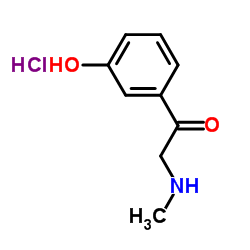
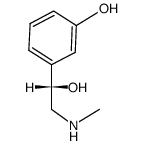
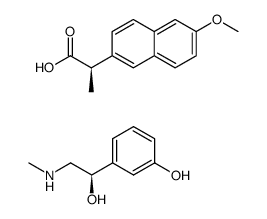
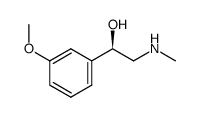

![(±)-3-hydroxy-alpha-[(methylamino)methyl]benzyl alcohol structure](https://image.chemsrc.com/caspic/054/1477-63-0.png)
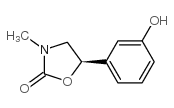 CAS#:110193-49-2
CAS#:110193-49-2 CAS#:61-76-7
CAS#:61-76-7